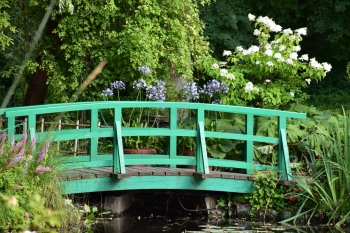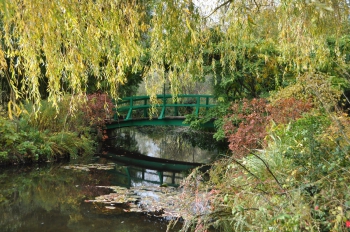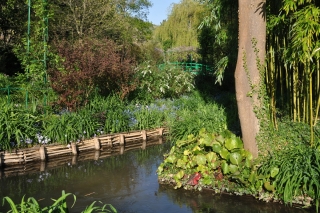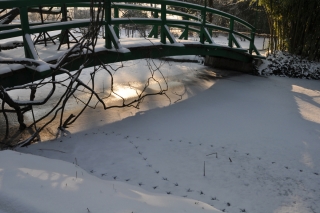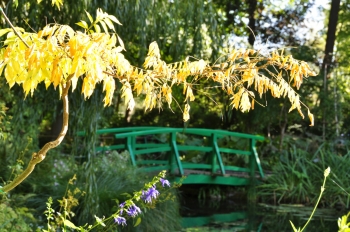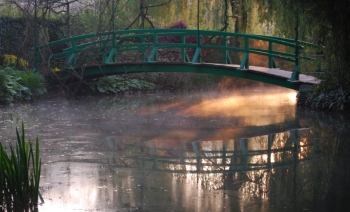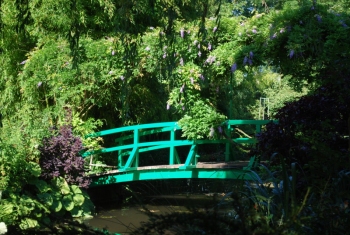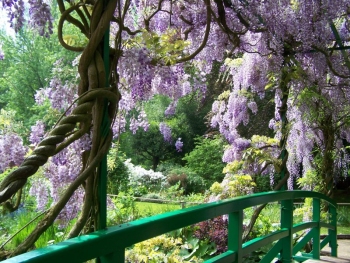This charming little bridge stands at one end of Claude Monet’s water lily pond in Giverny, over the small canal that used to bring some water into the pond. Agapanthus grown in planters and white hydrangeas cultivated like trees grace the place. Does this scene look familiar to you? It recalls many famous works of the artist. But as iconic as it sounds, Monet never painted this little bridge in his garden, but the big one only. Now covered with a canopy of wisterias, the big bridge has lost some of its likeness with Monet’s paintings.
Monet’s Little Japanese Bridge
July 24, 2018
November at Giverny
November 10, 2014
Do you want to have a look at the Monet Garden while it is closed for the winter?
Here is the Japanese bridge as it was this morning.
Giverny is now closed for five months.
The village will awake again next spring.
The first day for visiting the gardens will be Saturday 28 March, 2015.
Perspective
May 17, 2014
Claude Monet designed his water garden from scratch, turning a marshland into a beautiful waterscape to paint.
His eye as a painter can be noticed in the much thought of composition of the garden.
Every where perspectives draw the sight, offering a ready made composition to the artist.
Monet’s Pond
May 20, 2012
This is Monet’s pond at Giverny seen from the Japanese Bridge in May, when the wisterias are in bloom.
The water lily pads float like islands on the surface. No flowers yet.
Short before closing time, visitors are few. The late afternoon sunshine enlightens the trees on the eastern side of the pool. Silence falls on the garden. The scent of the flowers is in the air.
Snowy Giverny
February 8, 2012
It is hard to imagine that in seven weeks, the gardens will be full of flowers again. For the moment, it is icy and snowy at Giverny.
Yesterday morning, I visited the closed and cold Monet garden. It was probably the most beautiful day of the winter. A few inches of snow covered pond and park, and shined in the sunlight. It looked so still and sleepy… But life is not far away, just hiding in every little hole.
Under the Japanese bridge, a bird has stamped its very regular footsteps, designing new curves to add to those imagined by Claude Monet.
Monet Small Bridge
October 7, 2010
Two curved bridges face one another on both ends of Monet’s pond at Giverny.
The big one is covered with wisterias, whereas the small one doesn’t have any.
But a neighbouring wisteria can give the illusion that it is covering the little bridge too!
Its golden color brightens all the greens around.
Sunrise on Giverny
May 1, 2010
Early in the morning, long before the first visitor arrives in Monet’s garden at Giverny, rays of orange sunshine stroke the Japanese bridge of the water garden, while a light mist raises from the pond.
Monet, who was an early bird, loved to get up before sunrise, in order not to miss a second of the dramatic show of light and water.
Vantage Point
July 10, 2009
The dock offers good views on the small bridge over Monet’s pond at Giverny.
There are six bridges in Monet’s water garden, the biggest being the one Monet painted so often. But the smaller bridge at the other end of the pond is very charming also.
This side of the garden is bathed by the sun in late afternoon. The warm light generates beautiful reflections on the surface.
One would like to do like Monet, just sit down and gaze at the water for hours, scrutinising the changing colors of nature.
April Light
April 8, 2009
This is how Monet’s garden looked on April 1st, the very first morning it was open this year.
The morning sun enhances the pure lines of the Japanese bridge, whereas the air is full of scent from spring flowers like daffodils, pansies and hyacinths.
The light of this early hour has pink and blue notes and a very special vaporous quality.
Everything looks renewed and fresh, ready for a new start.
Monet’s Japanese Bridge
October 24, 2008
This is the Famous Japanese Bridge that Claude Monet painted so often.
It deserves lots of capitals because it has become the icon of the painter’s garden at Giverny.
In the bright sunshine its green turns almost blue, as can be observed on Monet’s paintings of this motive.
The picture was made in July when the wisteria tangled on the arbor flowers for a second time. This second blooming while the leaves are out is by far more discreet than the first one in May.
Series Painting: A Small World
September 11, 2008
Claude Monet made his garden famous by painting it over and over again. There are 272 canvases by Monet featuring his water garden, not to speak about the Grandes Decorations, these oversized panels that can be seen at l’Orangerie Museum in Paris.
Monet didn’t want any other motive for almost twenty years. He was in his seventies and eighties and didn’t feel like travelling for long painting campaigns anymore.
In addition there was war, the first World War from 1914 through 1918. Monet preferred to stay in his garden to paint. Here he found all the inspiration he needed.
Monet painted his pond or his bridge repeatedly, because for him there were never the same. What he wanted to render was not especially a flower or a bridge, but the light on them, the air that wraps them. And the light changes all the time.
Blooming Wisteria
May 14, 2008
The wisteria is at its peak over the Japanese Bridge in Claude Monet’s garden.
Its flowers look like long grapes. They are a soft tone of lavender and produce a delicious scent which recalls to the scent of jasmine.
It is an incredible feeling to stand on the bridge and be surrounded by the blooming wisteria all around you.
The beautiful effect doesn’t last very long, but Monet had thought of a special jocker. A second later wisteria will follow the lavender one when it is over. The second one is a white wisteria.
